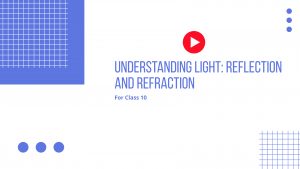NCERT Solutions for Science Class 10 Chapter 15
NCERT Solutions for class-10 Science chapter 15 “Our Environment” is curated by senior and experienced teachers of EduAid. Before answering the questions of Chapter 15 , read the theory of the chapter multiple times and get a clear understanding of the concepts included in the chapter.
Here are the answers of the questions included in the NCERT book. Before diving deep into the answers, try to attempt the questions by yourself.
ANSWER THE FOLLOWING QUESTIONS
1. Why are some substances biodegradable and some non-biodegradable?
Answer: Substances which can be acted upon by microorganism (decomposer) are called biodegradable. For example- vegetable wastes, paper, cotton etc.
On the other hand, materials which are not acted upon by decomposers are called non-biodegradable. For example- plastic, glass, polyethene etc.
2. Give any two ways in which biodegradable substances would affect the environment.
Answer:
(a) They will serve as breeding ground for flies and mosquitoes which are carriers of disease like cholera, malaria etc.
(b) They produce foul smell, thus causing air pollution.
3. Give any two ways in which non-biodegradable substances would affect the environment.
Answer:
(a) Excess use of non-biodegradable pesticide and fertilizers run off with rain water to water bodies causes water pollution.
(b) They may choke the sever system of city or town that may overflow over roads.
4. What are trophic levels? Give an example of a food chain and state the different trophic level in it.
Answer:
Each step in a food chain constitutes a trophic level. For example
Grass \(\rightarrow\) Dear \(\rightarrow\) Lion
Trophic level I Trophic level II Trophic level III
5. What is the role of decomposers in the ecosystem?
Answer:
They decompose dead remains of plants and animals and their wastes organic products into simple inorganic substances which are released into the atmosphere for reuse by the plants. Thus, they help in recycling of materials.
6. What is a ozone and how does it affects any ecosystem?
Answer: Ozone is a form of oxygen. It has the molecular formula \(O_3\). It is present at a higher level in the atmosphere. It protects the ecosystem from the harmful effects of ultraviolet rays coming from the Sun. UV rays may cause skin cancer, cataract to us.
7. How can you help in reducing the problems of waste disposal? Give any two methods.
Answer:
The following measures can be adopted for reducing the problem of waste disposal:
(i) Reduce the volume of wastes by burning in incinerator.
(ii) Produce compst and biogas from biodegradable waste.
8. Which of the following groups contain only biodegradable items?
(a) Grass, flowers and leather
(b) Grass, wood and plastic
(c) Fruit-peels, cake and lime-juice
(d) Cake, wood and grass
Answer:
(a) Grass, flowers and leather
(c) Fruit-peels, cake and lime-juice
(d) Cake, wood and grass
Above are the groups that contain only biodehradable items. Since is not a biodegradable substance, that group cannot be considered biodehradable.
9. Which of the following constitute a food-chain?
(a) Grass, wheat and mango
(b) Grass, goat and human
(c) Goat, cow and elephant
(d) Grass, fish and goat
Answer: (b) Grass, goat and human
Here, the grass is the producer, the goat is the primary consumer, and the human is the secondary consumer.
10. Which of the following are environment-friendly practices?
(a) Carrying cloth-bags to put purchases in while shopping
(b) Switching off unnecessary lights and fans
(c) Walking to school instead of getting your mother to drop you on her scooter
(d) All of the above
Answer: (d) All of the above
11. What will happen if we kill all the organisms in one trophic level?
Answer: If we kill all the organisms in one trophic level, the number of individuals in the next trophic level will decrease due to non-availability of food. Also, the number of individuals in the previous trophic levels will increase because there is no one to feed on them. This will cause imbalance in the environment.
12. Will the impact of removing all the organisms in a trophic level be different for
different trophic levels? Can the organisms of any trophic level be removed without causing any damage to the ecosystem?
Answer: Yes, the impact of removing all the organisms in a trophic level will be different for different trophic levels. For example, on removing producers; herbivores would not be able to survive or they would migrate and ecosystem would collapse. If herbivores are removed, producers would grow unchecked and carnivores would not get food. If carnivores are removed, herbivores would increase to unsustainable levels and could destroy the producers. If decomposers are removed, the dead animals would pile up due to which the environment would become polluted. In addition to this, if dead animals will not decompose, the recycling of nutrients in the soil will be stopped and its fertility will be reduced. As a result the green cover of the earth will be lost. Thus to maintain the balance of the ecosystem the presence of organisms is necessary at each trophic level.
13. What is biological magnification? Will the levels of this magnification be different at different levels of the ecosystem?
Answer: The phenomenon of progressive increase in concentration of certain harmful non-biodegradable chemicals such as DDT at different levels of food chain is called biological magnifications.
The concentration of harmful chemicals will be different at different trophic levels. It will be lowest in the first trophic level and highest in the last trophic level of the food chain.
14. What are the problems caused by the non-biodegradable wastes that we generate?
Answer:
(a) Non-biodegradable pesticides and fertilizers run off to water bodies to cause water pollution.
(b) Some of the non-biodegradable pesticides like DDT enter the food chain and cause biomagnifications in humans and other animals.
15. If all the waste we generate is biodegradable, will this have no impact on the
environment?
Answer: It will have only short term impact on environment, the action of decomposers will slow down and some air/water pollution will be caused. However, in longer term, there will be no impact of biodegradable wastes on the environment.
16. Why is damage to the ozone layer a cause for concern? What steps are being taken to limit this damage?
Answer: The damage to the ozone layer is a cause for concern because if the ozone layer in the atmosphere disappears completely, then all the extremely harmful ultraviolet radiations coming from the sun would reach the earth. These ultraviolet radiations would cause skin cancer and other ailments in men and animals and also damage the plants. In an attempt to protect the ozone layer, the United Nations Environment Programme (UNEP) unanimously forged an agreement among its member countries to freeze CFC production at 1986 levels.
Study materials
- Refernce Books
- NCERT Solutions
- Syllabus







